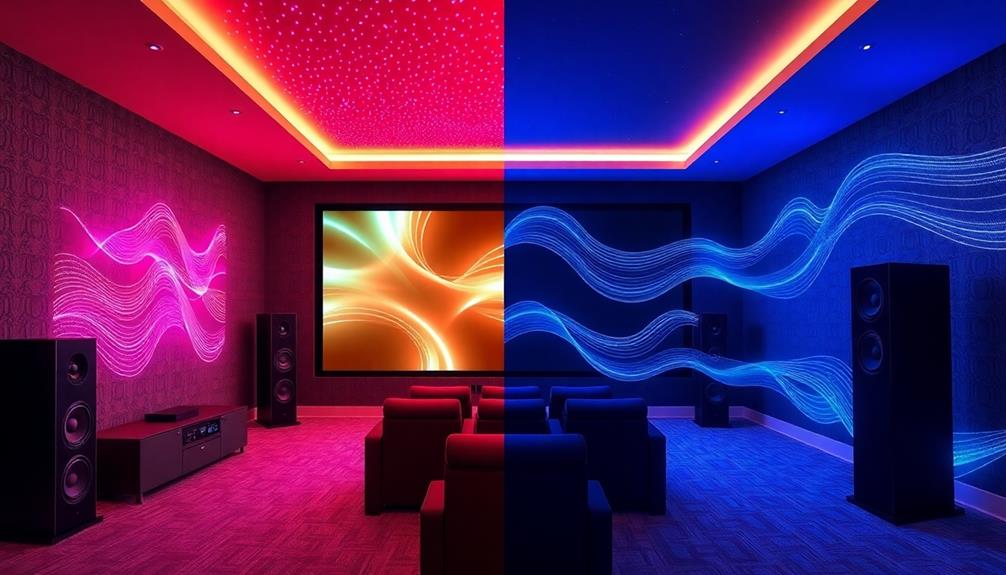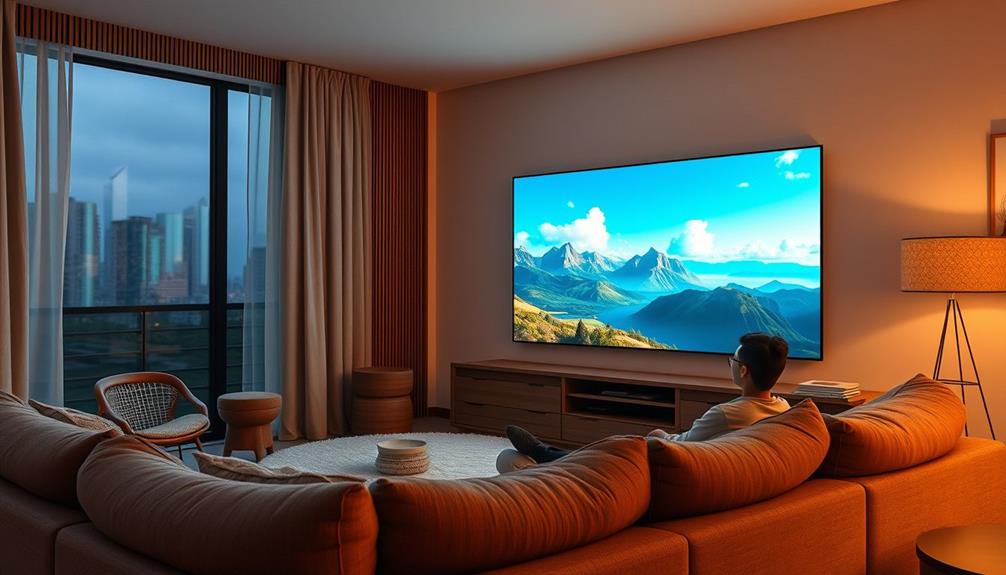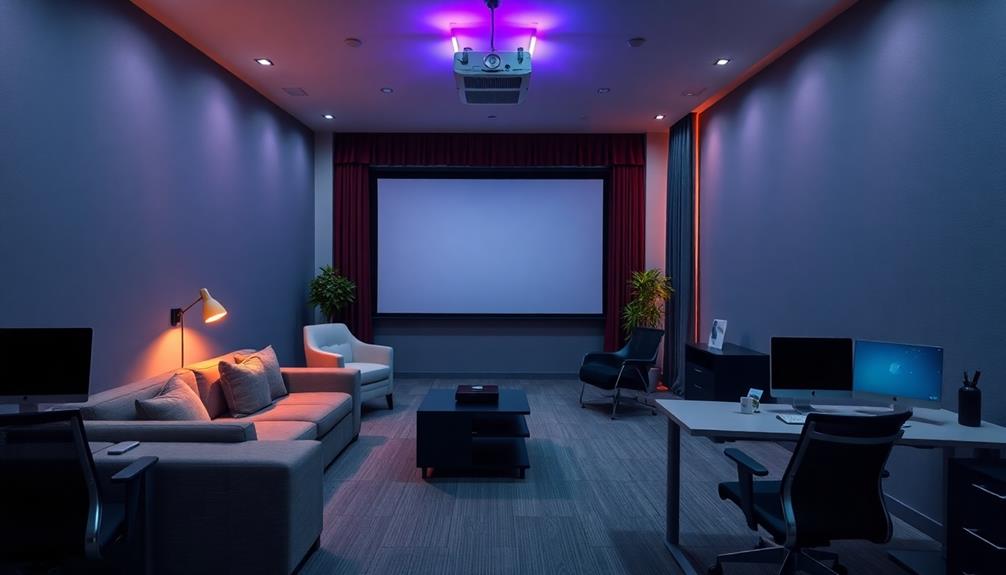When you compare projectors and TVs, projectors usually come out ahead environmentally. They consume less energy, often between 50 to 150 watts, while TVs can exceed 400 watts. This means projectors typically have a smaller carbon footprint. Plus, their lifespan can reach up to 20,000 hours, reducing electronic waste. TVs, while durable, tend to create more waste due to their higher replacement rates. Both options have their pros and cons, but considering projectors could support a more sustainable viewing experience. If you're curious about further insights, there's plenty more to explore on this topic.
Key Takeaways
- Projectors generally consume less energy than TVs, leading to a smaller carbon footprint and lower electricity costs.
- The lifespan of projectors, especially LED and laser models, can reach up to 20,000 hours, reducing electronic waste.
- TVs typically produce more electronic waste due to shorter lifespans and frequent replacements compared to projectors.
- Projectors emit less blue light, mitigating risks of digital eye strain and enhancing viewer comfort.
- Choosing projectors over TVs supports long-term sustainability and eco-friendly practices due to their reduced environmental impact.
Energy Consumption Comparison
When it comes to energy consumption, projectors often emerge as the more eco-friendly option compared to TVs. When you compare the power usage, many projectors operate within the range of 100-300 watts, while high-end TVs can exceed 400 watts during use. This difference makes projectors a more sustainable choice, especially if you watch for extended periods.
Additionally, using projector maintenance tips can help guarantee your device runs efficiently, further reducing energy consumption. LED and laser projectors are particularly impressive, requiring only 50-150 watts, which considerably reduces energy consumption. In fact, the average yearly energy usage for a 4K TV can range from 100-400 kWh, whereas projectors typically consume only 50-200 kWh annually, depending on how often you use them.
Moreover, projectors generally have a longer lifespan with fewer internal components needing replacement. This longer lifespan contributes to their eco-friendly nature, as they not only consume less power but also minimize waste over time.
With energy efficiency ratings and eco modes becoming more common in projectors, you can further reduce energy consumption during operation. So, if you're looking to lower your environmental impact, choosing a projector over a TV could be a smart move.
Lifespan and Maintenance

While projectors can offer an enchanting viewing experience, their lifespan and maintenance needs often raise concerns. Typically, projectors have a shorter lifespan, especially traditional models that require lamp replacements every 2,000 to 4,000 hours. In contrast, LED and laser projectors can last up to 20,000 hours, but this still falls short of TVs, which often exceed 50,000 hours.
Additionally, just as butter enhances the texture and flavor of dishes, a well-maintained projector can notably elevate your viewing experience, making the effort worthwhile for some users. However, the ideal temperatures for cooking with butter highlight the importance of maintenance in achieving the desired results, which parallels the care needed for projectors.
As a user, you'll find that projector maintenance requirements can be more demanding, including regular cleaning of filters and bulb replacements. This upkeep not only adds to your long-term cost of ownership but also contributes to electronic waste over time.
TVs, on the other hand, generally require less maintenance, leading to lower costs and a reduced environmental impact. Dust accumulation can notably affect a projector's ideal performance, making regular cleaning essential.
TVs are less prone to such issues, making them more user-friendly in the long run. So, when considering lifespan and maintenance, it's clear that while projectors can deliver stunning visuals, the ongoing care and shorter lifespan may make TVs a more sustainable choice for the environmentally conscious consumer.
Electronic Waste Impact

When you consider electronic waste, the lifespan and durability of your device play a vital role.
Projectors often last longer and consume less energy compared to TVs, which can lead to reduced waste and a smaller carbon footprint.
Additionally, using devices like ozone air purifiers can help improve indoor air quality during usage, further enhancing their environmental benefits.
Plus, understanding the recycling and disposal practices for each option can help you make a more environmentally friendly choice.
Lifespan and Durability
Durability plays an essential role in determining the environmental impact of electronic devices, particularly when comparing projectors to TVs. Projectors typically have a lifespan of 2,000 to 20,000 hours, while modern TVs last between 30,000 to 100,000 hours. This significant difference contributes to varying rates of electronic waste generation.
The longevity of TVs also aligns with the idea of personal fulfillment and relationship satisfaction in remarriage, where making a sustainable choice can lead to long-term benefits.
Consider these aspects:
- Frequent lamp replacements for projectors
- Regular maintenance needs like cleaning
- Higher electronic waste from shorter projector lifespans
- TVs' more durable components reducing waste
- Recycling programs available for projector waste
As you can see, the need for more frequent upgrades with projectors results in a larger carbon footprint.
TVs, on the other hand, thrive on their longevity and lower failure rates. While both technologies are evolving towards sustainability, the durability of TVs generally leads to less immediate electronic waste.
Energy Consumption Comparison
Energy consumption is an essential factor to take into account when evaluating the environmental impact of projectors versus TVs. Generally, projectors consume less power than traditional TVs, with many modern models using around 100-300 watts, while TVs can exceed 400 watts. This makes projectors more energy-efficient, especially for larger screens.
Additionally, as the demand for renewable energy sources like geothermal energy continues to grow, the overall environmental impact of electronic devices can be further mitigated.
One significant advantage of projectors is their longer lifespan. LED and laser projectors can last up to 20,000 hours, reducing the need for frequent replacements compared to TVs. This longevity contributes to lower electronic waste over time.
Moreover, projectors usually have fewer internal components than TVs, which further minimizes electronic waste generated throughout their lifecycle.
While both projectors and TVs contribute to electronic waste, the combination of lower energy consumption and a longer lifespan for projectors may result in a smaller carbon footprint overall.
In addition, projectors can create larger images, allowing for reduced energy consumption per square inch of display compared to smaller TVs.
Recycling and Disposal Practices
The growing concern over electronic waste (e-waste) requires us to rethink how we dispose of and recycle devices like projectors and TVs. With e-waste being one of the fastest-growing waste streams, improper disposal can greatly harm our environment.
In fact, the financial implications of poor e-waste management can be severe, with recycling initiatives potentially offering tax advantages associated with IRA accounts for companies engaged in sustainable practices.
Consider the following when recycling your devices:
- Rare earth metals that are challenging to reclaim
- Sensitive circuit boards needing specialized processing
- Hazardous substances like lead and mercury in TVs
- Longer lifespan of projectors, meaning fewer units discarded
- Low recycling rates, with only 17% of e-waste recycled properly
You can help mitigate the environmental impact by choosing responsible recycling options.
Projectors, while lasting longer, still require careful disposal due to their materials. TVs often pose greater risks due to their hazardous components.
As a result, it's essential to follow local regulations, such as the EU's WEEE Directive, which mandates proper disposal practices.
Carbon Footprint Analysis

When comparing the carbon footprints of projectors and TVs, it's clear that projectors often come out on top. Projectors consume less energy, especially when leveraging LED or laser technology. In fact, their average energy consumption ranges from 50 to 300 watts, whereas modern 4K TVs generally consume between 100 to 400 watts. This difference means that projectors can have a considerably lower carbon footprint during extended use.
Additionally, projectors have a longer lifespan, often exceeding 20,000 hours, compared to TVs, which typically last 5 to 10 years. This longevity reduces electronic waste and contributes to a smaller environmental impact. Projectors also produce less heat, leading to lower energy usage for cooling systems in your home.
Here's a quick comparison of the two:
| Device | Average Energy Consumption | Lifespan |
|---|---|---|
| Projector | 50 – 300 watts | 20,000+ hours |
| 4K TV | 100 – 400 watts | 5 – 10 years |
With their lower energy consumption and reduced carbon footprint, projectors present a more eco-friendly option for your viewing needs.
Sustainability of Display Technologies

When you compare energy consumption between projectors and TVs, you'll often find that projectors use less power, especially during extended viewing.
Additionally, many modern projectors come equipped with smart features that enhance their usability and efficiency, similar to the way garage door openers improve home security.
Plus, with lifespans that can exceed 20,000 hours, projectors can outlast traditional TVs, which helps cut down on electronic waste.
This sustainability factor makes projectors an appealing choice for eco-conscious consumers.
Energy Consumption Comparison
In comparing energy consumption, projectors often emerge as a more sustainable option than TVs, especially for extended viewing.
Smart projectors typically consume less power than traditional TVs, making them a better choice for energy-conscious consumers. The advancements in AI solutions enhance efficiency for various technologies, including display systems.
The average energy consumption for projectors ranges from 150 to 300 watts, while modern 4K TVs can hit between 100 to 400 watts, depending on size and settings.
- LED and laser projectors offer longer lamp lives, often exceeding 20,000 hours.
- Projectors produce less heat during operation, leading to lower cooling costs.
- A smaller carbon footprint is linked with projectors due to reduced energy demands.
- Less frequent replacements mean less waste in landfills.
- Extended viewing sessions become more eco-friendly with projectors.
Lifespan and Durability
Choosing between projectors and TVs often hinges on their lifespan and durability, which play a crucial role in sustainability. Projectors can last anywhere from 2,000 to 20,000 hours, depending on the light source, with LED and laser options typically offering longer durability. In contrast, traditional TVs, especially those with OLED technology, boast an impressive lifespan of 50,000 to 100,000 hours. This makes them more durable and potentially a better long-term investment.
Additionally, just like how cats may show signs of separation anxiety when their owners leave, the choice of display technology can also lead to emotional responses based on user experience.
When it comes to maintenance, projectors require regular lamp replacements and dust management, leading to higher long-term costs and increased waste due to the disposal of used bulbs and filters. TVs generally need less ongoing maintenance, which results in lower resource consumption and waste.
While the production process for both technologies involves significant resource usage, projectors often have a smaller carbon footprint during operation, particularly if you opt for energy-efficient models.
Ultimately, considering lifespan and durability helps you make a more sustainable choice, balancing maintenance needs, resource consumption, and long-term costs effectively.
Blue Light Emission

Amid growing concerns about digital eye strain, blue light emission from screens has become a critical topic for viewers. It's crucial to understand how projectors compare to traditional TVs in this regard.
Research shows that hydration strategies can also play a role in reducing eye strain during prolonged screen time. Projectors emit considerably less blue light, reducing potential risks. High-energy blue-violet light can cause blurry vision and headaches.
The reflective light from projectors is less intense than the direct light from TVs. Sitting further away from a projector minimizes glare and harshness. Modern projectors, like the ViewSonic X1-4K, feature low blue light technology.
These factors contribute to a more comfortable viewing experience, especially during extended sessions. With projectors, you're less likely to experience symptoms associated with blue light exposure, such as digital eye strain or potential retinal damage over time.
Environmental Benefits of Projectors

Projectors offer considerable environmental benefits that make them an appealing choice for eco-conscious consumers. One of the most notable advantages is that projectors consume less energy than traditional TVs, often using just 150-300 watts, compared to TVs that can exceed 400 watts. This can lead to lower electricity costs and a reduced carbon footprint.
Additionally, projector bulbs, especially LED and laser types, boast impressive lifespans ranging from 20,000 to 30,000 hours. This longevity considerably reduces electronic waste, as you won't need to replace parts as frequently as with TVs, which often require panel replacements after a shorter period.
Moreover, projectors produce less heat during operation, promoting energy efficiency by minimizing the strain on your air conditioning systems and lowering cooling costs in your home.
Another eco-friendly aspect is that many projectors use fewer toxic materials in their construction, avoiding harmful chemicals like mercury.
Recycling and Disposal Practices

When it comes to recycling and disposal practices, the differences between projectors and TVs can markedly impact the environment.
Projectors typically have a longer lifespan and fewer internal components, leading to less electronic waste. However, you need to be mindful of the hazardous materials found in many projector lamps, like mercury, which require special recycling programs.
On the other hand, TVs can release harmful chemicals during disposal, making proper recycling vital.
Here are some key points to take into account:
- Utilize certified e-waste recycling services to guarantee responsible disposal.
- Avoid landfill overflow by recycling your old devices properly.
- Watch out for hazardous materials that may contaminate the environment if not handled correctly.
- Look for designated e-waste recycling centers that safely process and recover valuable materials.
- Understand the environmental impact of improper disposal, which can affect your community.
Long-Term Environmental Considerations

Choosing between projectors and TVs involves more than just viewing preferences; it also impacts long-term environmental sustainability. Projectors consume less energy than traditional TVs, which means lower carbon emissions over time. This makes projectors an eco-friendly option for extended viewing periods.
Additionally, advancements in LED and laser technology have led to longer-lasting light sources in projectors, often lasting up to 20,000 hours. This longevity reduces the frequency of replacements and associated electronic waste. By opting for projectors, you can also help reduce overall material consumption, as they require fewer components compared to larger TVs.
Here's a quick comparison:
| Aspect | Projectors | TVs |
|---|---|---|
| Energy Consumption | Lower | Higher |
| Lifespan of Light Sources | Up to 20,000 hours | Typically shorter |
| Material Consumption | Fewer components | More complex components |
Future Trends in Display Technology

As advancements in display technology continue to evolve, both projectors and TVs are set to benefit from a strong emphasis on energy efficiency and sustainability.
You'll notice that manufacturers are prioritizing greener practices, particularly with the rise of LED projectors and MicroLED technology. These developments promise reduced power consumption and enhanced visual quality, offering high brightness and color accuracy without the downsides of burn-in seen in OLED displays.
Expect to see:
- Transparent displays that blend seamlessly into your environment
- Smart displays equipped with integrated connectivity
- Enhanced streaming capabilities for effortless device interaction
- Use of recyclable materials in production
- A significant reduction of harmful substances in displays
These trends not only support eco-friendly practices but also cater to your desire for cutting-edge technology.
As sustainability becomes essential, the shift towards energy-efficient products will likely transform your viewing experience, making it more enjoyable and environmentally responsible.
Embracing these innovations will help you stay ahead while contributing to a healthier planet.
Conclusion
In choosing between projectors and TVs, you're not just picking a display; you're making a choice for the environment. Projectors often use less energy, last longer, and generate less electronic waste. By supporting sustainable technology, you're reducing your carbon footprint, promoting recycling, and ensuring a healthier planet for future generations. So, whether it's for entertainment or education, remember: every decision counts, every choice matters, and every action contributes to a greener tomorrow.
Hello, I’m Art, and I’m excited to be a part of the 1Home Theatre Projector team. As a writer, I’m here to contribute my knowledge and insights to help you achieve the ultimate home cinema experience. I understand that making decisions in the world of home entertainment can be complex, and I’m here to simplify the process for you.
















